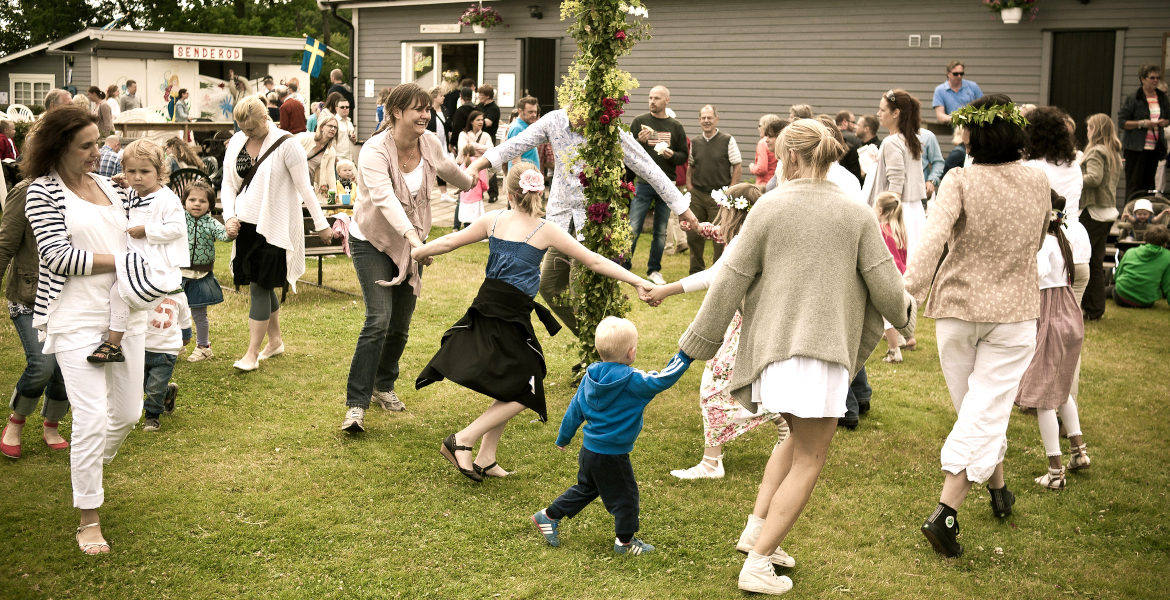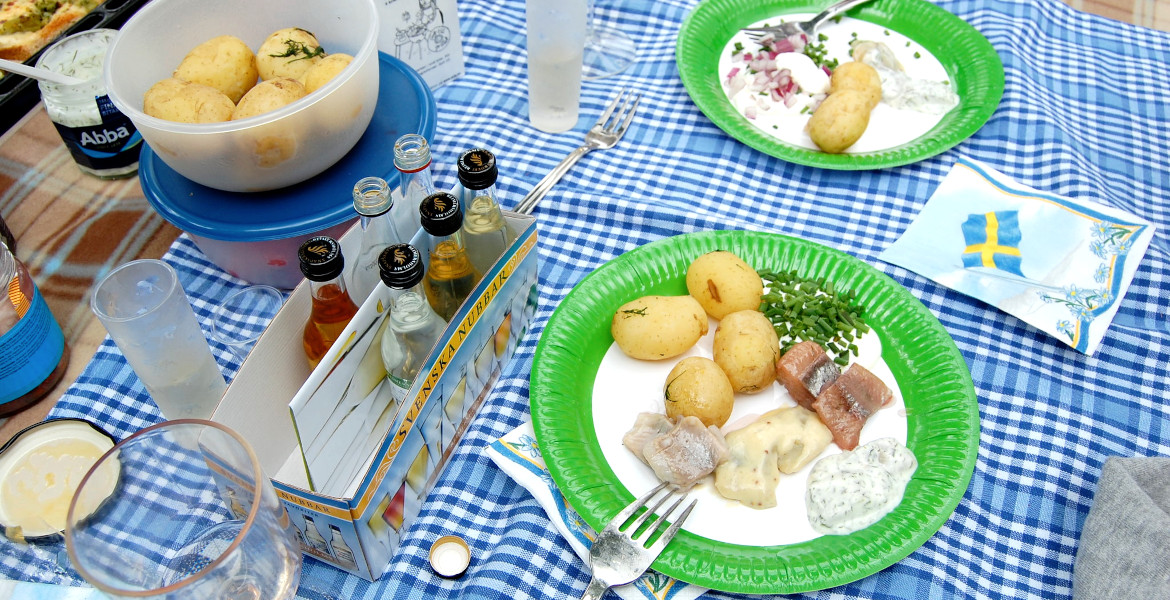Midsummer marks the definitive arrival of summer. It means exactly what it sounds like, “in the middle of summer,” and the word already existed in Old Swedish as miþsumar. The holiday is celebrated in connection with the summer solstice, which is the time of year when the sun is at its highest point in the northern hemisphere. Midsummer Eve is always celebrated on a Friday.
This article was first published on June 21, 2024.
In northern Europe, midsummer has long been celebrated in conjunction with the Christian holiday of John the Baptist, which is also the reason why Saturday has become a public holiday. In Finland this holiday is primarily called Juhannus, in reference to John the Baptist. Denmark and Norway also celebrate John the Baptist’s evening by lighting bonfires and playing games. John the Baptist’s Day is also celebrated to some extent in Germany, but generally the summer solstice celebrations in the rest of Europe are fairly limited.
Ancient roots
It is not clear for how long Midsummer has been celebrated, as it seems to date back to prehistoric times, but it is definitely known that it has been celebrated in the Nordic countries at least since the Middle Ages.
However, very little is known about how Midsummer was celebrated in the Middle Ages. There are hints that the celebration was related to fertility and some older sources that show that there was ritual beer drinking and also blot – ritual animal sacrifice – during the Viking Age.

Summer cleaning and little frogs
From around the middle of the 19th century, there is more clear evidence of how the celebrations were carried out in Sweden.. One important step was to clean the entire house, then dress the house both inside and outside with flowers and leaves from birch trees, among other things. The festive locations were also decorated with leaves, as were the wagons in which people traveled. Outside the house, leaf bushes were placed, which the farmers could also sell to the townspeople.
The midsummer pole has its origins in the May Day celebrations when a so-called maypole is erected in Germany and other parts of the world. The tradition probably came from Germany to Sweden in the Middle Ages, but since the Nordic countries rarely have time to start greening during May, this tradition was moved to the Midsummer celebrations. There is a widespread belief that the midsummer pole is dedicated to fertility and thus may represent some kind of phallic symbol, although there is no confirmation of this from known historical sources.
The midsummer pole has had different designs over the years, but during the 20th century the appearance was standardized and the midsummer poles became increasingly similar all over the country. Dancing around the midsummer pole has probably existed since at least the 19th century, says Jonas Engman, curator at the Nordic Museum.
– But the dance with songs took off in the 1920s. This era saw the publication of songbooks with melodies and lyrics associated with holiday celebrations.
Perhaps the most classic Swedish midsummer song – Små grodorna (the little frogs) – has been traced to a military march from the French Revolution called La Chanson de l’Oignon, or The Onion Song. This song was turned into a taunt by English soldiers, replacing the word camarade (comrade) with grenouille (frog). It is unclear when or how the song came to Sweden, but it is known that it has existed for a long time at Nääs Castle in Västergötland in connection with courses in handicrafts and games, where The little frogs was a game taught there and printed in the singing games book Sånglekar från Nääs in 1922. The singing of The little frogs is typically associated with jumping around the midsummer pole in a frog-like manner.
Food
What people used to eat around Midsummer depended on where they were in the country. Different types of fish, but also pork and other meat have all been part of the feast in different places. White porridge, that is, porridge cooked with milk and often also with wheat flour, is a dish that was common as a festive meal in various places. A Swedish filbunke, or viili in Finnish, is a fermented milk dish similar to yogurt or kefir which also used to be a common feature of the midsummer feast.
In modern times, herring and new potatoes constitute the core of the menu, along with the classic strawberries. Spirits of various kinds are just as essential – together with a good snapsvisa, of course! A snapsvisa is a traditional Scandinavian drinking song, often with comical lyrics.

Midsummer magic
It has long been thought that the boundaries to the supraphysical reality were thinner during Midsummer. Everything that grew was considered to be charged with magical powers, especially during this time. It was therefore common, for example, to tie a wreath during Midsummer and save it. For the same reason, there was also a belief that one could regain energy during the winter by placing a dried midsummer wreath in the annual Christmas bath.
Midsummer dew, in particular, was considered to have special powers and it was not uncommon to roll around naked in it, or to collect the dew in sheets, for example, because it was thought to improve health. Drinking from springs was also common during Midsummer, which was considered beneficial to the body and mind. However, all activities involving any kind of magical aspects would be done in silence, so as not to break their mystical effect.
Keeping silent at certain special places could also bring visions of the future. For example, it was common to walk the so-called årsgång (year walk), which could involve walking counter-clockwise around a church or other holy place on an empty stomach.
– If the ‘yearwalker’ completed the entire ritual, on the way home he would experience sights or sounds that told him about events in the coming year, says Tora Wall, folklorist at the Nordic Museum.
Night of love
Midsummer has long been associated primarily with love. Many young women in Sweden still pick their seven or nine flowers and put them under their pillow to find out who they are going to marry.
“The Midsummer night is not long but sets seven and seventy cradles in motion” is an old Swedish rhyme.
Another way to predict one’s future partner was to eat a dream porridge made of flour, water and a lot of salt. The person who came later in the dream and gave you a drink to quench your thirst was your future partner. The type of drink could also give a hint as to whether you would have a richer or poorer life together.
Young people often arranged mock weddings and could choose a midsummer bride and groom, often each with their own floral wreath. It was also not uncommon for girls to tie wreaths to the boys to show that they were a couple.
A de facto national day in Sweden
In Sweden, the National Day celebration on June 6, commemorating the coronation of Gustav Vasa in 1523, has traditionally not been as big a holiday as National Day is in many other countries. One of several explanations for this, in addition to the long period of peace in Sweden, is probably that the nearby Midsummer celebration has de facto been the really big and obvious holiday alongside the more quiet Christmas.
That said, we would like to wish all readers a glad midsommar!






























































